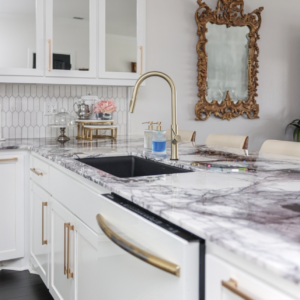With its timeless elegance and luxurious appeal, it is a popular choice for countertops, floors, and sinks in homes worldwide. Its unique veining and smooth finish add a touch of sophistication to any space. However, marble is also a porous natural stone, making it susceptible to stains.
The thought of a stained marble surface can be daunting, leading to concerns about maintenance and longevity. But fear not! With the right knowledge and techniques, you can effectively learn how to clean marble and restore its original luster. This guide will walk you through the best practices for cleaning marble, addressing common stains, and maintaining its beauty for years to come. Whether you’re dealing with a stubborn spill on your kitchen countertop, trying to figure out how to clean marble floors, or looking to refresh your marble sink, we’ve got you covered.
How to Clean Stained Marble?
Cleaning stained marble requires a gentle yet effective approach, as harsh chemicals can etch or damage the stone. The key to successful stain removal lies in identifying the type of stain and acting quickly. Most stains can be treated with a poultice — a thick paste designed to draw out impurities from the porous stone.
When learning how to clean stained marble, remember to always begin with the gentlest method and gradually move to stronger solutions if necessary. It’s also crucial to test any cleaner on an inconspicuous area first. As with quartz, experts like Martha Stewart recommend avoiding vinegar, bleach, or abrasive scrubbing tools, which can cause permanent damage.
Identifying the Type of Stain
Understanding the nature of the stain is the first step in knowing how to clean stained marble effectively. Stains can generally be categorized into:
Organic stains: from food (berries, tomatoes), beverages (coffee, tea, wine), or cosmetics.
Oil-based stains: from cooking oils, grease, lotions, or wax.
Inorganic stains: from ink, paint, rust, or water rings.
Once you know the stain type, you can choose the right treatment. For example, organic stains often respond to hydrogen peroxide, while oil-based ones may require absorbent materials like cornstarch or baking soda.
How to care for Marble?
Regular cleaning is essential for preventing stains before they set. A mild dish soap and warm water solution, wiped with a soft microfiber cloth, is the safest method. This approach is also recommended by experts as part of how to care for marble proactively.
Avoid acidic cleaners like vinegar or lemon juice, and never use abrasive pads. Always dry marble thoroughly after cleaning to prevent water spots.
How to Clean Marble Countertops?
Marble countertops are beautiful but prone to spills and stains. Learning how to care stained marble in this context involves:
Oil-based stains: Blot, then sprinkle cornstarch to draw out oils. Repeat until clear.
Organic stains: Use hydrogen peroxide with paper towels, covered with plastic wrap, to lift discoloration.
Ink stains: Dab rubbing alcohol onto the spot.
Water marks: Buff gently with superfine steel wool.
Regular sealing every 3–6 months adds a protective barrier.
How to Clean Marble Floors?
Marble floors require extra attention because of heavy foot traffic. Sweep or vacuum first, then mop with warm water and a pH-neutral cleaner for stone.
If you need to know how to clean marble floors, the poultice method works well for localized stains. Always dry the floor immediately after mopping to prevent mineral deposits from forming.
How to Clean a Marble Sink?
Marble sinks, like countertops, can suffer from stains and water spots. If you’re wondering how to clean a marble sink, the process is simple: wipe it daily with mild dish soap and warm water, then dry thoroughly. For tougher stains, use a gentle poultice or hydrogen peroxide solution, but avoid acidic cleaners.
Maintaining Your Marble
Beyond stain removal, proactive maintenance is essential. Always use coasters, cutting boards, and trivets. Wipe up spills immediately and reseal your marble surfaces periodically.
Understanding how to clean stained marble and applying the right techniques for countertops, sinks, and floors ensures your surfaces remain a stunning focal point in your home. With proper care, you’ll never have to worry about stains compromising your marble’s natural beauty.





